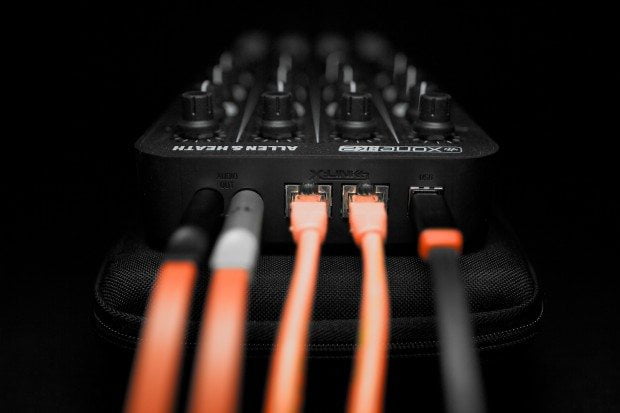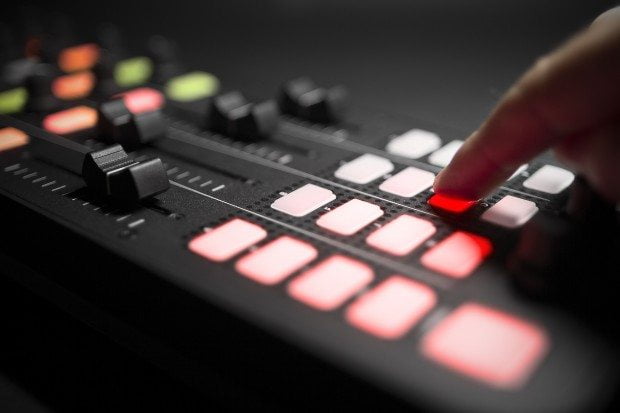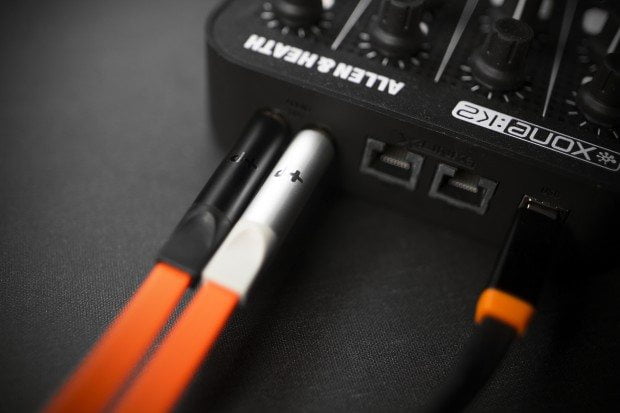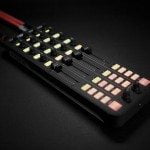Link: Allen & Heath – Price: $299/€249/£199
Introduction
Ah, timing. I don’t know whether this is something to do with the hive mind that people are talking more and more about since Twitter became a ‘thing’, but the amount of controllers that are pointing towards the exact same workflow, all coming out within a timeframe too condensed to allow us to infer much in the way of copycat tactics, is staggering. Allen & Heath beat pretty much everyone to the punch with their Xone K2 announcement at last year’s BPM, and they’ve had the DJ community on tenterhooks since.
In the Box
The Xone K2 has an excellent selection of value adders in the box. For a start, there’s a particularly well padded carry case that doubles up as a stand to raise the K2 to turntable/mixer height. My only real reservation with the case is that when using it as a stand, the sheer amount of padding and protection it’s equipped with adds quite a lot of bulk and means that setting it up completely flush with the rest of your equipment isn’t really possible. I’d have preferred to have seen some sort of riser system built into the case that can be removed and allows a Xone K2 to sit right in the cut between two other pieces of equipment, or even possibly a built in kick stand system, but I’m splitting hairs a little bit here. It’s great that it’s included.
As well as the expected USB cable there’s an RJ45 cable (X-Link uses RJ45 pinout, but the connections are customised. You can use an RJ45 cable, but I don’t advise experimenting with plugging the Xone K2 into networks!) for connecting multiple K2s together, or a K2 to enabled A&H mixers, and a software disk. Digitally speaking A&H have made a real effort to ensure that despite the flexibility that seems central to the K2’s design, users that just want to plug and play are catered for. There are multiple Traktor Pro mappings, for two decks, four decks, a Native Instruments Traktor Kontrol X1 emulator (more on that later), an Ableton Live map, blank overlays ready for printing, and of course drivers for everything.
I was a little surprised not to see any Serato love, and I double checked to make sure I hadn’t missed a configuration utility akin to the controller editors frequently seen bundled with other developers’ products, but keeping the MIDI assignments on the unit’s physical controls is probably a good idea to keep the layering the K2 is capable of manageable.
How it Feels
The buttons on the Xone K2 are immediately gratifying; a reassuring clicky action with very short travel means that you can place a lot of confidence in them mission critical functions like cue juggling and transport. Perhaps it’s just a little squished for really going to town with the 4×4 section as if it were a pad controller, but it’s spaced well enough that you won’t worry about tripping up on nearby buttons. They light up brightly – not retina burningly so, but they give off enough of a glow to allow you to see in daylight as well as behind a dark DJ booth.
The knobs are super soft and just feel generally lovely. They’re marginally lighter than most other developers’ implementations, and for quick adjustments they work really well. The rotary encoders feel very good too, I tend to prefer either a very clicky feel or a completely smooth one for encoders and they sit much more towards the clicky. The push button functionality of the encoders is a bit spongey – I’d have preferred a bit more ‘clunk’ in this area.
The faders are really light and smooth, but I have two reservations about them. Firstly, they tend to wiggle a little from side to side. It’s not a huge amount, but it’s enough to notice. Secondly, they feature studio style mixer caps rather than DJ pinch style ones. I suppose that this is a matter of preference, but it means that you can’t grab multiple faders (you have to ‘finger’ them) and the general speed with which you can manipulate them is reduced. Further, A&H’s decision to use studio style stems means that you can’t switch on your favourite 4mm caps as you might have hoped – they just won’t fit.
Multi Layer Controls
Multi-layered control is a somewhat divisive ideology. Whilst it’s always good to have options, if you start adding layer upon layer of functionality to a controller it gets increasingly confusing and more likely you’ll make a mistake – especially if you haven’t printed out labels for the device.
Once you’ve decided that flexibility is more up your street than strict 1:1 labelled mapping, though, more really is more and A&H have gone to town on the options for the Xone K2’s layering system. You never need to play with layers if you don’t want to, but if you do (and you should, to get the most out of the unit) then pressing the layer button switches between three layers, and you can decide whether every control on the unit, only the 16 buttons, only the buttons below the knobs, or all the buttons (but not the knobs or sliders) is part of the layer switch. This is all done by powering the Xone K2 on into setup mode by holding down a push encoder as you plug it in, and there are a combination of button presses that change how the latching is implemented, with the buttons illuminating themselves by way of indication.
The buttons are capable of three colours, which is predictably handy for at a glance understanding of the three layers and other software functions. NI are about to show the world just what true RGB LEDs can do, but three colours are just fine for the K2’s capabilities.
I’m torn when it comes to my opinion of the layering system, to be brutally honest. I think the concept and implementation behind the latching layer system is a little over complicated for non-techy users, and whilst there’s definite bonuses for power users that create multiple layers without the headaches of complicated MIDI implementation mapping and pages of software assignment, the ability to change the MIDI messages sent from the unit on each layer would be, in my eyes, a more elegant solution. Actually, elegant might not be the word, because the logic behind the whole system is sound and facilitates jumping into software and learning controls whilst essentially leaving the Xone K2 a static device, so maybe ‘flexible’ or even ‘powerful’ is the word I’m searching for.
Having three ‘universal’ layers and simply duplicating mappings between them for controls that you don’t want to change does more or less the same thing as latching certain sections of the controller, indeed providing even more flexibility still. However, because software like Ableton Live and Scratch Live don’t like having multiple MIDI messages mapped to the same software control, this isn’t always an option.
It’s great that A&H have provided their MIDI implementation charts and diagrams for quick reference for mappers, but better still in my humble opinion would be a controller editor that allows mapping of the MIDI implementation to the actual unit.
Audio Quality
One of the biggest draws for prospective K2 users is Allen & Heath quality sound. Even without the audio interface, the K2’s a pretty good value proposition, but add in master and monitor outputs and you’re really getting a good deal. The audio circuitry is top notch, and the K2 can blast out plenty of power to keep up with the big boys. The headphone out is tremendously loud and clear, so if you’re using your K2 to send audio to a club sound system and monitor from the unit itself you should be fine.
16/44.1 (or 48) is starting to look a bit old specs wise, but the good news is that the sound coming out of the K2 is very good indeed. It’s not as loud as an NI card, but it’s definitely loud enough and the latency keeps pace just fine. The crazy amount of dynamic range and clarity from its Xone DB brethren isn’t quite there, but there are no concerns from me about the quality of the sound.
X-Link
X-Link is a proprietary connection that allows A&H devices to speak to and power each other. With USB ports dropping like flies on new computers (okay, mainly Macs), anything that allows a device to daisy chain is a good thing. Better still is the fact that power for the device will be drawn from the host if it’s plugged into the mains, so if you absolutely must use a USB hub for whatever reason, a Xone mixer/K2 combo won’t be swallowing precious power.
In X-Link mode, the Xone K2 adds controls to its host rather than simply piggybacking hub style. That is to say it won’t appear as a separate device in your software, but its MIDI mapping remains exactly the same. This is super cool, because it means that all you have to do if you go to a venue that has an X-Link enabled mixer is plug the mixer in instead of your K2, and the K2 into the mixer, and things will operate exactly as if it were in standalone with all the advantages of keeping a single MIDI I/O to your software. It does mean that you’ll have to be mindful of the channels you use for your K2, as you’ll end up with conflicts if your custom mapping uses the same channel as the default mapping for an X-Link mixer, but sticking to A&H’s factory channel mapping will keep you safe.
X-Link doesn’t transmit audio, which means you can’t slave a K2 to a Xone DB mixer or another K2 and use the audio outputs. It’s a shame, but it’s not the end of the world. The K2’s small but sweet audio interface is perfect for giving pro sound out of a small setup, and I can’t really think of a use case where a master out and a headphone out isn’t enough for you; either your master out goes into a mixer/PA with more output options, or you go straight into a small speaker setup.
VS the X1
Obviously the K2 and Native Instruments’ Kontrol F1 are directly comparable; whilst the K2 has audio outputs, the F1 has the advantage of being directly integrateable into Traktor 2.5’s advanced remix deck functions. We’ll make a full comparison between the two in a future piece, but for now let’s look at the NI’s Kontrol X1 in comparison to the Xone K2.
The K2 includes an X1 emulation template that does a very good job of aping the functionality of the X1, although of course the main advantage of the NI way is that the controller is laid out specifically for its functions, with labelled fascia to match. Labelling aside, the K2 has so many advantages over the X1 that to put them in direct competition is a little fascile.
Size wise the K2 dwarfs the X1, and the build quality is more impressive too; nutted pots add stability and durability whilst the buttons have a more responsive feel. The extra size is put to good use, with the conspicuous addition of sliders and considerably more knobs and buttons.
In short, the K2 does everything the X1 does and more, so unless you have a burning desire to keep everything NI the K2 is a better choice for transport and effects control. As I said, the F1 is more suited to direct competition with the K2, so that’s where our attention will be for our future VS piece.
Final Thoughts
I like the Xone K2 a lot. Perhaps it’ll really come into its own when Traktor’s remix decks are opened up to third party control, but even without that aspect of control on its side it’s a great pairing with any software for cues, loops, effects, transport… basically all the things you could need from a slim controller. Add to that a solid build and a good audio interface and A&H have a bit of a winner on their hands.
Ratings
Build Quality: Great. It’s sturdy, the controls are all smooth and soft, and the extra mile – nutted controls and an included carry case – ensure that the K2 will cope with professional use.
Sound Quality: It doesn’t run as hot as an NI box, and it doesn’t quite ‘glisten’ in the same way that a well designed 24 bit card does, but I’ve no complaints as to the sound level or quality.
Features and Implementation: More controls than you can shake a stick and and a clever layering system and a dual stereo output interface, plus a carry case, plus mappings in the box? Lots of plus points. I wanted to see a config utility for mapping the MIDI implementation, though.
Value for Money: Compare the K2 to other controllers that have the same number of controls and you’ll soon see that it’s the quality of A&H engineering that makes it really stand out. If you don’t care about audio at all then it takes a hit in the value stakes, but if you do then it’s difficult to find anything that can compete. Oh, and the case just makes things sweeter.

































